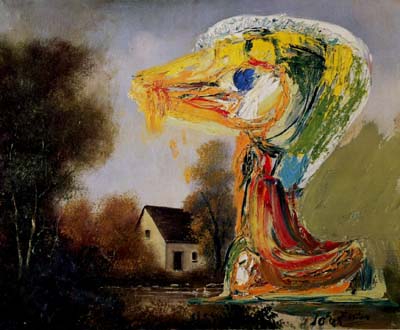

A fun Situationist and painter from Denmark. The second painting is especially awesome--"detournement" without a rigid and pedantic political objective...that's something I always thought lacked in the Situationists' "art." Instead of reconstructing and re-examining space in their (anti) art, as they did in their theory, they stuck to the format of literal insertion of theory into spectacular mediums...Jorn rejected their somewhat teleological "end of art" stuff and created art which felt close to the "form follows fun" idea that founded their urbanography and psychogeographic ideas. If "modern" art itself can be seen as a spectacle, where does the category of "art" end, and how could a new urban geography which emphasized psychic pleasure and interactive personality be defined as somehow oppositional to this spectacular art? Is a new format somehow stricken from the category of "art" simply because of its creator's opposition to what that category has hitherto entailed? This is a point which has always bothered my in Situationist dogma. And it is true that their critiques often attain a sort of dogma in interpretation and appropriation; there is almost a "thou shalt not" lingering in the background of their theory-- "thou shalt not create 'modern art' "--as though, with the immense myriad of expressions this elusive term has been applied to, there is somehow a linear, temporal, and categorical end to this term. "Modern" and "postmodern" are not times so much as tendencies which mark a particular time more than another. But this is only retrospective-- had the Situationists not been careful to be adamant, almost absolutist in their dogma, and had they actually made more practical moves to re-interpret space in a tactile fashion, "history" would undoubtedly have called their work a sign of the times, modern art for modern times, etc. The sharp lens of art criticism could be considered the antidote to this generalizing tendency which formed the flimsy foundation for the Situationists' repudiation of the production of modern art. Instead of a radically sharp critique of individual expressions within an already shakily-defined "epoch" of art, or, more precisely, epoch of capitalism taking expression in this mode of art, the Situationists preferred to see artistic expression in a tight vaccuum and analyze it thusly. Without going into a deeper critique of the Situationists' aims, failings, and successes, suffice to summarize that though their critique was valid, timely, and incredibly important to contemporary subversive thought, it is dangerous and dulling (of the sharp point of critique) to take up its more ideological expressions (especially on art) as an absolute template for future creations. The Situationists were not art critics, they were critics of art, and they weren't critics of art from its own merits but from its placement within commodity-representation society. The work of Asger Jorn could be seen as an element of the negation of ideology which the Situationists so desperately wanted to espouse, but failed, in their persistence upon actions directed in a certain fashion, being utilized in strict and general opposition to a large scheme of antithecal production.

No comments:
Post a Comment